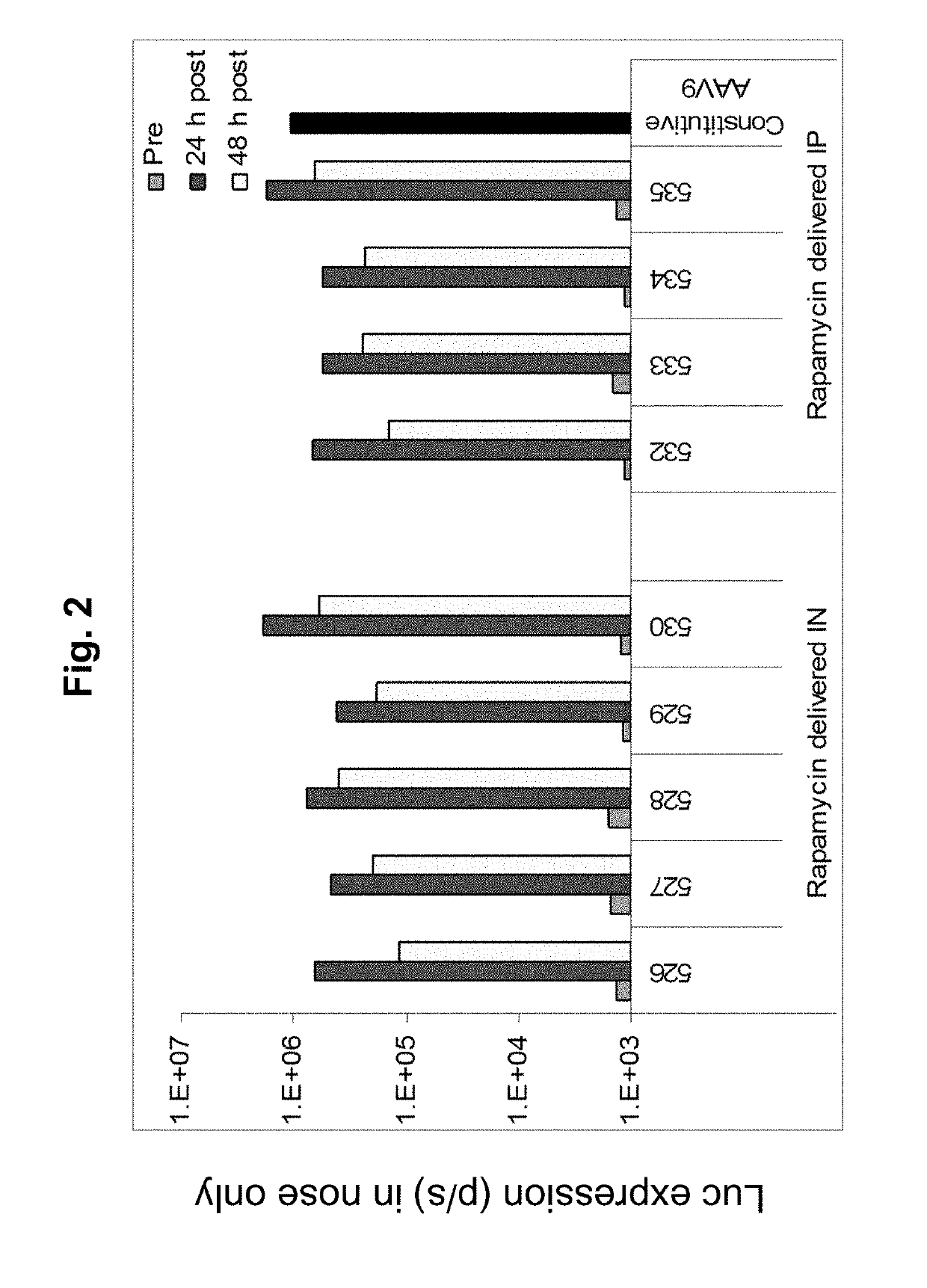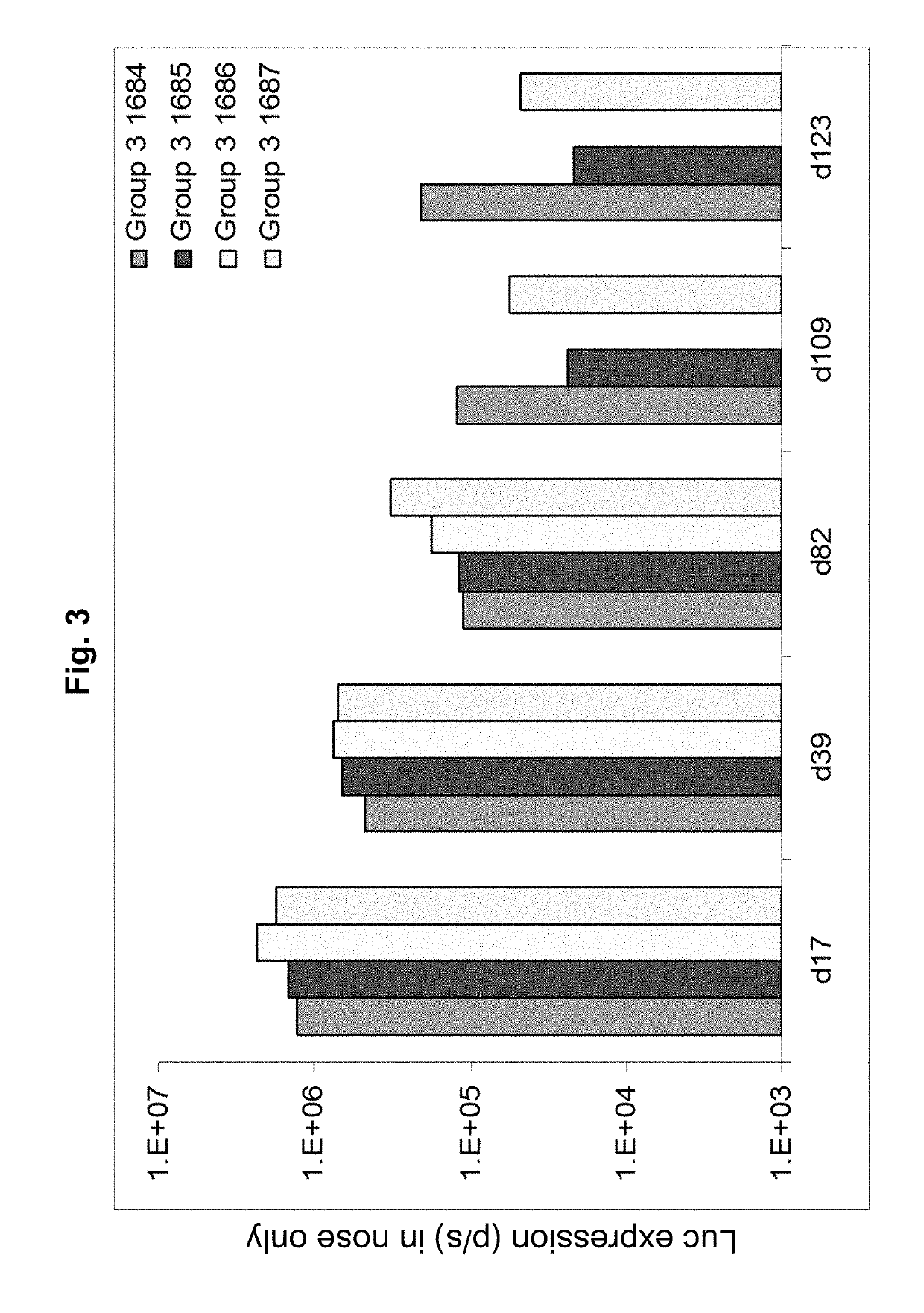Regimens and Compositions for AAV-Mediated Passive Immunization of Airborne Pathogens
a technology of aav and composition, which is applied in the direction of immunoglobulins, antibody medical ingredients, peptides, etc., can solve the problems of small molecule drugs such as amantadine and neuraminidase inhibitors, and the ineffective control of disease spread of small molecule drugs such as neuraminidase inhibitors
- Summary
- Abstract
- Description
- Claims
- Application Information
AI Technical Summary
Benefits of technology
Problems solved by technology
Method used
Image
Examples
example 1
ion of AAV-Ab Vectors
[0090]Specific human broadly neutralizing antibodies are cloned in highly efficient lung-directed AAV vectors. Initially, CR6261 [D. C. Ekiert, et al, “Antibody recognition of a highly conserved influenza virus epitope”, Science, 324 (5924), 246-251 (2009)] a broadly-neutralizing Ab isolated by Crucell (Holland), is cloned into an AAV vector construct and produce AAV9 vector. The sequences of this antibody are available from WO 2010 / 130636-A1 (18 Nov. 2010), see, e.g. sequences 186 and 184), and the NCBI data base accession numbers: 3GBN L GI: 224983685 (light chain), 3GBN H (heavy chain). Briefly, to generate a mAb AAV expression construct, VH and VL [lambda] domains from CR6261 are cloned into constitutive expressing AAV vectors. This particular IgG1 constant region is known to support proper pairing with lambda light chains and to confer effector functions that support virus neutralization. Protein expression levels from the Ab will be confirmed in vitro by W...
example 2
n of Animal Models Following Challenge with Pathogenic Viruses
[0091]A. Mouse Models
[0092]In initial experiments the mAb vectors will be used. Briefly, the efficacy of the AAV-MAb vector will be assessed in BALB / c mice by delivering the AAV vector intranasally (IN). The titer of Ab will be assessed in nasal lavage and bronchoalveolar lavage fluids as well as in serum. Twenty-eight days later the vector-treated mice will be challenged under ABSL2 conditions using an IN bolus of a lethal dose of the mouse-adapted A / Puerto Rico / 8 / 34 (H1N1) flu strain (PR8-MTS). Mice will be monitored daily for clinical signs of influenza infection apparent as interstitial pneumonia and significant loss (<30%) of body weight. These challenge experiments will be repeated with a lethal dose of ABSL3+ level pathogenic strains of influenza H5N1 [Hanoi 2005: A / Hanoi / 30408 / 2005; Vietnam 2004: A / Vietnam / 1203 / 2004; Hong Kong 1997: A / Hong Kong / 483 / 1997; Indonesia 2005 A / Indonesia / 05 / 2005] and H1N1 [1918: A / South ...
example 3
n of Animal Models Following Challenge with SARS-CoV and EBOV
[0098]The therapeutic potential the passive vaccine of the invention is assessed in challenge studies with EBOV in mice and guinea pigs, and SARS-CoV in ferrets. In a similar manner as described above for influenza, mice and guinea pigs will be inoculated IN with AAV-expressing neutralizing anti-EBOV Abs (anti-ebola antibodies) and challenged with the mouse-adapted Zaire EBOV (EBO-Z) virus (mice) and the EBO-Z virus (guinea pigs). For the SARS-CoV challenge studies, ferrets will be inoculated IN with AAV-expressing anti-SARS-CoV Ab and challenged with SARS-CoV of the Toronto-2 strain. As mentioned earlier, mice and ferrets will also be subjected to an aerosol exposure of EBO-Z virus and SARS-CoV to model the infection following exposure to a sneeze or a cough.
PUM
| Property | Measurement | Unit |
|---|---|---|
| volume | aaaaa | aaaaa |
| time | aaaaa | aaaaa |
| time | aaaaa | aaaaa |
Abstract
Description
Claims
Application Information
 Login to View More
Login to View More - R&D
- Intellectual Property
- Life Sciences
- Materials
- Tech Scout
- Unparalleled Data Quality
- Higher Quality Content
- 60% Fewer Hallucinations
Browse by: Latest US Patents, China's latest patents, Technical Efficacy Thesaurus, Application Domain, Technology Topic, Popular Technical Reports.
© 2025 PatSnap. All rights reserved.Legal|Privacy policy|Modern Slavery Act Transparency Statement|Sitemap|About US| Contact US: help@patsnap.com



